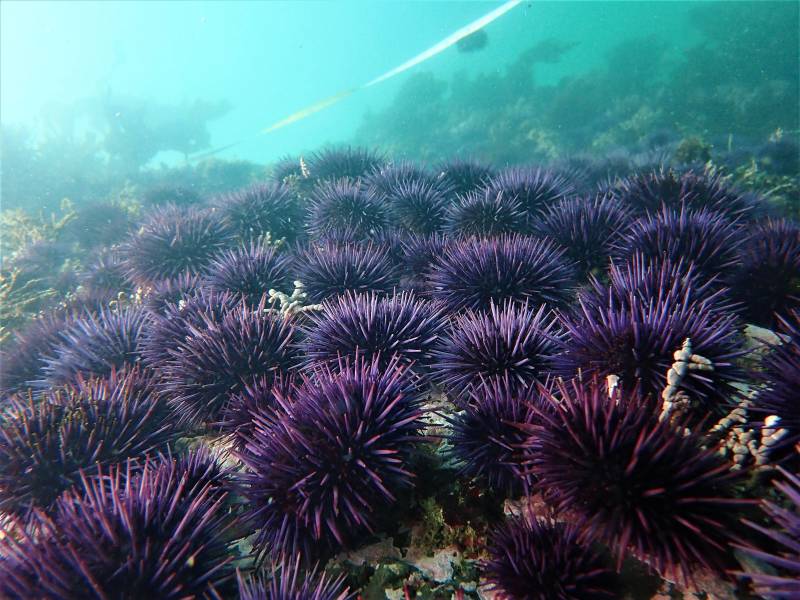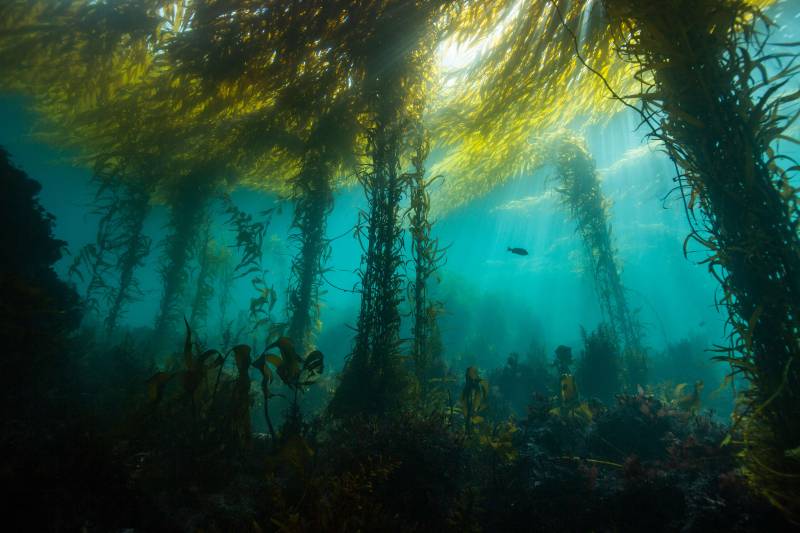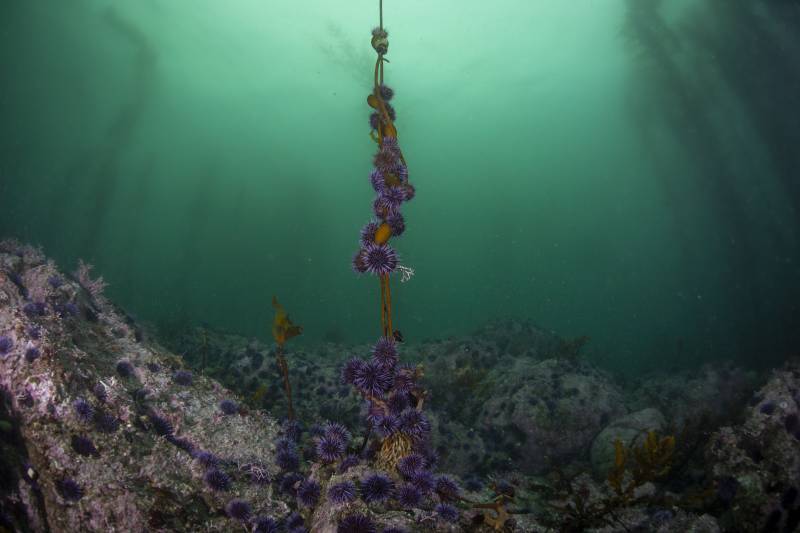Player FM ऐप के साथ ऑफ़लाइन जाएं!
Kelp, Sea Otters and Urchins. Who’s Eating Who in Monterey Bay
Manage episode 287465476 series 2486058
Marine scientists have observed a massive decline of California’s underwater kelp forests in recent years. Studies have linked the die-off to a host of factors including an ocean heat wave, a deadly sea star virus, and an influx of voracious kelp-eating sea urchins.
Kelp’s long flat leaves and bulbous stems provide habitat for marine mammals, fish and invertebrates in tidal regions along California’s coast. In many regions where kelp once flourished, the ocean floor is now carpeted with spiny purple sea urchins and there’s no kelp to be found. Scientists call these zones the urchin barrens.
A new study out of UC Santa Cruz reveals more about the disappearance of California’s kelp forests, finding the leafy green seaweed is faring better in places where sea otters, a natural urchin predator, are thriving.

Several studies have documented the collapse of the kelp ecosystem in California. The story goes something like this: A giant, warm-water “blob” first observed by scientists off the Washington coast in 2013 combined with an El Nino weather event from the south resulted in a prolonged marine heatwave in California from 2014-16. Kelp thrives in colder tidal waters, which have the nutrients it needs to survive. Faced with warmer water, the kelp essentially starved.
The historically hardy plant, which can grow up to 2 feet per day, could have bounced back from the heat wave, but for a disease that that nearly eradicated sunflower stars along the West Coast. This large, 24-limbed starfish feeds on purple sea urchins; without stars around, urchin populations swelled and changed their typical hunting behavior. Instead of merely grazing on fallen kelp leaves, the urchins began gobbling up the kelp’s stalks and seed pods as well.
In Northern California, satellite images have revealed a roughly 95% decline in kelp forest canopy as a result of these events. But in Central California waters, kelp has fared somewhat better.
The Central Coast saw a similar urchin outbreak in 2014, says Joshua Smith, a Ph.D. candidate and kelp forest researcher at UC Santa Cruz. “But what was different here was that instead of having this widespread kelp deforestation, we actually had this patchy mosaic of kelp forests interspersed with these patches of sea urchin barrens,” he said.

Smith says this unique phenomenon gave his group an opportunity to look closer at the factors driving the kelp decline and its potential for recovery.
The study, published this week in Proceedings of the National Academy of Sciences, links the presence of sea otters in Monterey Bay to patches of lush, healthy kelp forest.
Smith called Monterey Bay “sea otter country,” pointing out more of the species inhabited the area than any other in the state.
“This is a sea otter country,” Smith said. “We have the highest abundance of sea otters here in Monterey Bay than anywhere else in the state.”
Sea otters, like sunflower stars, are a natural predator of sea urchins.
“The key finding of what this actually means is that otters are so important for this ecosystem because they are maintaining these remnant patches of kelp forests,” Smith said, “And those patches of kelp are the ultimate source populations to help replenish those barren patches.”
The study shows that the sea otter population in Monterey Bay grew in the wake of the urchin boom, with an increased survival rate for pups.
While scientists can’t say for sure, the lack of sea otters and other urchin predators north of the San Francisco Bay may help explain why Northern California’s kelp forests have suffered more than on other parts of the coast.

Sea otters haven’t been spotted on the North Coast since the 1800s, says Meredith McPherson, a UC Santa Cruz marine scientist who recently published a separate study on Northern California’s kelp decline. “From what we observed in the satellite data from the last 35 years, the kelp had been doing well without sea otters as long as we still had sunflower stars. Once they were gone, there were no urchin predators left in the system.”
Without natural predators, McPherson says, scuba divers are helping maintain what’s left of the region’s kelp forests by plucking out interloping urchins. But while ocean temperatures and nutrient levels have normalized some since the 2014-16 heat waves, she says kelp haven’t seen any significant rebound.
“There seems to be some evidence that some patches of kelp have reemerged in certain areas, but it’s nothing to the extent that we would expect from the historical data,” she said. “The concentrations of urchins are still really high and [are] creating the strong grazing pressure on any kind of recovery.”
McPherson says while the urchin barrens persist, a full-scale kelp recovery is unlikely. Even without kelp to eat, urchins have shown resilience.
“That’s where some people have used the term zombie urchin,” Smith said. “These urchins are remarkable in that they can persist in this starved state in the sea urchin barrens for years.”
Smith’s study revealed that otters largely ignore urchins in the barrens, as they lack the nutritional value of those that have kelp to forage on. Scientists say another environmental event will likely be needed to reduce urchin populations and tip the scales in favor of kelp.
“A number of things could take out the urchins.” Smith said. “It could be urchin disease or it could be a bottom-scouring swell that physically wipes sea urchins off the reef.”
In the meantime, otters may be key to kelp’s chance for a long-term recovery.
65 एपिसोडस
Manage episode 287465476 series 2486058
Marine scientists have observed a massive decline of California’s underwater kelp forests in recent years. Studies have linked the die-off to a host of factors including an ocean heat wave, a deadly sea star virus, and an influx of voracious kelp-eating sea urchins.
Kelp’s long flat leaves and bulbous stems provide habitat for marine mammals, fish and invertebrates in tidal regions along California’s coast. In many regions where kelp once flourished, the ocean floor is now carpeted with spiny purple sea urchins and there’s no kelp to be found. Scientists call these zones the urchin barrens.
A new study out of UC Santa Cruz reveals more about the disappearance of California’s kelp forests, finding the leafy green seaweed is faring better in places where sea otters, a natural urchin predator, are thriving.

Several studies have documented the collapse of the kelp ecosystem in California. The story goes something like this: A giant, warm-water “blob” first observed by scientists off the Washington coast in 2013 combined with an El Nino weather event from the south resulted in a prolonged marine heatwave in California from 2014-16. Kelp thrives in colder tidal waters, which have the nutrients it needs to survive. Faced with warmer water, the kelp essentially starved.
The historically hardy plant, which can grow up to 2 feet per day, could have bounced back from the heat wave, but for a disease that that nearly eradicated sunflower stars along the West Coast. This large, 24-limbed starfish feeds on purple sea urchins; without stars around, urchin populations swelled and changed their typical hunting behavior. Instead of merely grazing on fallen kelp leaves, the urchins began gobbling up the kelp’s stalks and seed pods as well.
In Northern California, satellite images have revealed a roughly 95% decline in kelp forest canopy as a result of these events. But in Central California waters, kelp has fared somewhat better.
The Central Coast saw a similar urchin outbreak in 2014, says Joshua Smith, a Ph.D. candidate and kelp forest researcher at UC Santa Cruz. “But what was different here was that instead of having this widespread kelp deforestation, we actually had this patchy mosaic of kelp forests interspersed with these patches of sea urchin barrens,” he said.

Smith says this unique phenomenon gave his group an opportunity to look closer at the factors driving the kelp decline and its potential for recovery.
The study, published this week in Proceedings of the National Academy of Sciences, links the presence of sea otters in Monterey Bay to patches of lush, healthy kelp forest.
Smith called Monterey Bay “sea otter country,” pointing out more of the species inhabited the area than any other in the state.
“This is a sea otter country,” Smith said. “We have the highest abundance of sea otters here in Monterey Bay than anywhere else in the state.”
Sea otters, like sunflower stars, are a natural predator of sea urchins.
“The key finding of what this actually means is that otters are so important for this ecosystem because they are maintaining these remnant patches of kelp forests,” Smith said, “And those patches of kelp are the ultimate source populations to help replenish those barren patches.”
The study shows that the sea otter population in Monterey Bay grew in the wake of the urchin boom, with an increased survival rate for pups.
While scientists can’t say for sure, the lack of sea otters and other urchin predators north of the San Francisco Bay may help explain why Northern California’s kelp forests have suffered more than on other parts of the coast.

Sea otters haven’t been spotted on the North Coast since the 1800s, says Meredith McPherson, a UC Santa Cruz marine scientist who recently published a separate study on Northern California’s kelp decline. “From what we observed in the satellite data from the last 35 years, the kelp had been doing well without sea otters as long as we still had sunflower stars. Once they were gone, there were no urchin predators left in the system.”
Without natural predators, McPherson says, scuba divers are helping maintain what’s left of the region’s kelp forests by plucking out interloping urchins. But while ocean temperatures and nutrient levels have normalized some since the 2014-16 heat waves, she says kelp haven’t seen any significant rebound.
“There seems to be some evidence that some patches of kelp have reemerged in certain areas, but it’s nothing to the extent that we would expect from the historical data,” she said. “The concentrations of urchins are still really high and [are] creating the strong grazing pressure on any kind of recovery.”
McPherson says while the urchin barrens persist, a full-scale kelp recovery is unlikely. Even without kelp to eat, urchins have shown resilience.
“That’s where some people have used the term zombie urchin,” Smith said. “These urchins are remarkable in that they can persist in this starved state in the sea urchin barrens for years.”
Smith’s study revealed that otters largely ignore urchins in the barrens, as they lack the nutritional value of those that have kelp to forage on. Scientists say another environmental event will likely be needed to reduce urchin populations and tip the scales in favor of kelp.
“A number of things could take out the urchins.” Smith said. “It could be urchin disease or it could be a bottom-scouring swell that physically wipes sea urchins off the reef.”
In the meantime, otters may be key to kelp’s chance for a long-term recovery.
65 एपिसोडस
सभी एपिसोड
×प्लेयर एफएम में आपका स्वागत है!
प्लेयर एफएम वेब को स्कैन कर रहा है उच्च गुणवत्ता वाले पॉडकास्ट आप के आनंद लेंने के लिए अभी। यह सबसे अच्छा पॉडकास्ट एप्प है और यह Android, iPhone और वेब पर काम करता है। उपकरणों में सदस्यता को सिंक करने के लिए साइनअप करें।




